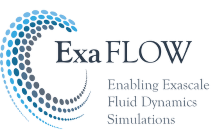ExaFLOW targets clearly defined innovations in the area of exascale computing and CFD, with the aim to enhance the efficiency and exploitability of an important class of applications on large-scale (exascale) systems.
Innovation 1: Mesh adaptivity, heterogeneous modelling, and resilience
Mesh adaptivity will reduce the cost of large-scale simulation through a more efficient use of resources, simplified grid generation and correctly calculated results. A heterogeneous modelling approach combining LES and quasi-DNS has accurately captured turbulent flow physics using only a fraction of the number of grid points required for a full DNS. To prevent losses in performance and efficiency when hardware errors occur, a library for multi-level in-memory checksum checkpointing and automatic recovery has been developed and is currently being tested.
Innovation 2: Strong scaling at exascale through a mixed CG-HDG
This approach will exploit the benefits of next-generation exascale computing resources by allowing individual jobs to be executed efficiently on a larger number of cores than presently possible. This will in turn allow large-scale complex flow simulations to be executed in shorterwall-clock times. Time reductions for execution of high-fidelity simulations will accelerate the design cycle for a range of industrial applications.
Innovation 3: I/O data reduction via filtering
The alleviation of the I/O bottleneck by considerable data-reduction before I/O has been successful for smaller data sets using Singular Value Decomposition (SVD) as a data compression method, which performs feature extraction in raw data. With exascale in mind, this method is currently being tested on large data sets.
Innovation 4: Energy-efficient algorithms
Energy and timing implications of reducing the clock frequency in different phases of Nektar++ have been investigated, highlighting the importance of appropriate parallelism.



